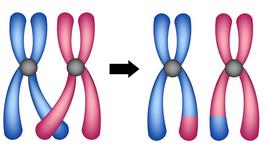Large DNA Integrations With Prime Editing and Recombinases
CMN Intelligence - The World’s Most Comprehensive Intelligence Platform for CRISPR-Genomic Medicine and Gene-Editing Clinical Development
Providing market intelligence, data infrastructure, analytics, and reporting services for the global gene-editing sector. Read more...
Welcome back to Making the Cut! In our previous installment we introduced to you to one of the last evolutions of CRISPR technology, prime editing!
In a nutshell, prime editing allows us to introduce alterations – insertions and deletions - in the genome without the need to generate a DSB. This is made possible by fusing a reverse transcriptase (RT) enzyme to a nickase-Cas9. The RT will use the information contained within a special kind of sgRNA – the pegRNA – to write a new sequence at the target site.
If reading this statement resulted in a huge question mark appearing before your eyes, we suggest a quick recap of our previous episode on how prime editing works.
Unlike in Mission Impossible, this article won’t self-destroy anytime soon, so we can wait.
Are you back? Good! Now let’s continue delving into the awesome world of prime editing!
Size matters: prime editing fails to efficiently introduce large insertions
As we mentioned before, prime editing is a big step forward compared to its close predecessor - base editing - as it allows us to do more than just a single nucleotide change. But still, it may seem limited compared to some of the things we can achieve with conventional CRISPR/Cas9 approaches.
It’s kind of like during an Apple Keynote where they present the brand-new iPhone – “the best ever made” – just for you to find out that there is no earphone jack anymore and that it only charges with a very expensive solar panel (sold separately, of course).
Typical.
One limitation of prime editing are large integrations. Indeed, prime editing seems unable – unlike CRISPR/Cas9 – to integrate pieces of information longer than 100-200 nt. At least efficiently.
This may be due to different reasons, like the prime editing complex not binding long enough to the target sequence for the RT to write such a long piece of information. Very long pegRNAs could also be unstable, resulting in low frequency of large ( >800 nt) integration events.
But as usual, challenges are the bread and butter of innovative minds, and today we will show you how this issue has been elegantly solved.
Some of you may have heard of twinPE and GRAND(PE). While very innovative and smart, these approaches did not fully solve the problem, so we won’t tease you with a half-backed product when the solution is already there! And it is simpler than you may think!
Making new friends: prime editing meets recombinases
First, we have to drive our DeLorean back to the early 2000s, a time Before CRISPR (B.C).
At this time, enzymes called recombinases attracted a lot of attention. Indeed, some of these recombinases have been used for years to generate cell lines or even in vivo models. We’re sure you’ve heard of the Cre-LoxP system, which still today is pretty popular. If you remember your basic molecular biology course, Cre is a protein that can recognize two identical LoxP sequences in the genome and recombine the two sites, eliminating the DNA sequence between them. Remember when you were a kid and had to build those forsaken cut and paste craft paper figures? The LoxP sites are kinda like the “cut here” line while Cre acts as both the scissors and the glue. And we made a beautiful new DNA sequence!

What you may not know is that recombinases are originally found in bacteriophages, a type of virus that infects bacteria. These proteins are essential for the bacteriophages’ own propagation within their host. In fact, once they have infected a bacteria, bacteriophages can integrate their own DNA and exploit the replicative machinery of the host cell to make many more copies of themselves.
But how can they do that? Well, thanks to a special class of recombinases known as – drum roll – integrases. Yep, we scientists were low on imagination on that day.
Anyway, these integrases recognize a specific sequence that is present both on the bacteriophage and the bacterial DNA, and catalyze the integration of the bacteriophage’s DNA into the bacterial DNA. Cut and paste again, but with two different pieces instead of one (ages 5-7).
The beauty? This process is very efficient and theoretically it has not limits to the size of what you can integrate
The problem? Human cells do not have a compatible sequence for a bacteriophage Integrase. No “cut here” line, at all. Yeah, we know, that’s good for our sake (no bacteriophages can infect us), but as a genetic engineer it’s kind of a bummer.
However, this was B.C. And those dark times are gone for good!
Team work makes the dream work
Now imagine that you have a new fancy tool – prime editing – which allows you to incorporate edits within the DNA without a double-strand break but has limited integration size.
On the other hand, you have a perfectly evolved machinery to integrate large DNA sequences, the integrases.
It is in the actual name, for CRISPR’s sake!
But, as we said, humans do not have a motif which is compatible with them.
But wait... the necessary sequence is only 46 bp long...which is a piece of cake for prime editing!
If you are facepalming yelling “it was right there!”, that’s a shared feeling.
In fact, two separate groups (Drag-and-drop genome insertion of large sequences without double-strand DNA cleavage using CRISPR-directed integrases - PMC (nih.gov)/Science | Prime Medicine) came up with the same idea: using Prime Editing to incorporate at the desired target site a recognition site for the Bxb1 integrase, called AttB (B stands for “Bacteria”). Yes, indeed, they used prime editing to draw a “cut here” line for the Integrase! Isn’t that genious? Of course, they then delivered the Bxb1 integrase and a DNA template containing the AttP (P stands for “Phage”) and let the integrase do its thing.

And as you can imagine, this worked like a charm. They could integrate, with high efficiency, sequences way larger than before. Hell, they even integrated an entire adenovirus in the genome. That’s a 35 kb – yeah, KB – monster!

But was this all for show? Not really. In fact this technology, known also as Passige (or PASTE, depending on whom of the two teams came first), is currently in Prime Medicine’s pipeline for the development of CAR-T cells using Prime Editing. In this case, Passige will be used to integrate a CAR-T transgene. This will be a great alternative to using standard integrative Lentivirus vectors or a combination of CRISPR/Cas9 and a DNA donor (if you want to learn more about how CAR-T’s are generated and how CRISPR technologies can help that process, check out this episode),
So there you have it, prime editing can now really do it all!
The flaw in the plan:
We know what you’re thinking: There is still a limitation, isn’t it? Otherwise, why shouldn’t we just kick CRISPR/Cas9 to the curb and use Passige instead?
Well, the main problem is that integration through Passige is not completely clean. In fact, during the integration process, we can still retrieve some portions of the AttB/AttP site. Like when you didn’t cut completely over the line and your craft didn’t look exactly right.
Yes, we know you cried. We did too, big time. It’s okay, really.
As you can imagine, if we want to repair a part of a large exon – for example – we can’t do that, because we will also bring in some of the AttB/AttP site. Luckily, there could be a way around it, but if you’re interested to know more, we are happy to discuss it separately, just drop us a message!
All right, that’s all for now regarding prime editing.
As usual, we leave you with a teaser for what’s coming next. Well, we have been away for a bit, so let’s make it two:
- Prime editing may be not the only one out there, so stay tuned for technologies which can do a similar thing, even though a bit differently.
- So far both base editing and prime editing were sold as “DSB-free”. But, if you read carefully our articles and the scientific literature, you notice that they do actually break the DNA. And sometimes even a nick can be a problem. Next, time we will talk about this issue and about a true DSB-approach, no excuses!
We hope you enjoyed this episode of Making the Cut and we will see you all very soon!
To get more CRISPR Medicine News delivered to your inbox, sign up to the free weekly CMN Newsletter here.
Tags
CLINICAL TRIALS
Sponsors:
Base Therapeutics (Shanghai) Co., Ltd.
Sponsors:
Base Therapeutics (Shanghai) Co., Ltd.







